Some individuals have dedicated decades and, in some cases, millions of dollars, to the development of flying cars. They are brimming with sky-high optimism (excuse the pun), but their labors have so far failed to deliver. That makes me wonder why the same level of effort hasn’t been focused on amphibious cars. A successful and practical example could serve its owner well, but that doesn’t mean that they don’t exist. This 1967 Amphicar 770 is a perfect example of the breed, but its dedicated owner is in a situation where they are left with little choice but to part with their beloved classic. It presents nicely, is a turnkey proposition, and is listed here on eBay in Lubbock, Texas. They set their BIN at $52,500 with the option to make an offer.
The Amphicar, which hit the market in 1960, was the brainchild of industrial designer Hans Trippel. If his name isn’t immediately familiar, one of his other designs may shed some light. When Mercedes-Benz was developing the 300 SL, it was Trippel who designed the iconic “gullwing” doors. Trippel’s vision of an amphibious car was brought to life by the Quandt Group, with vehicles produced between 1960 and 1965. However, unsold cars remained available until 1968, receiving titles that recognized their sale year. Quandt produced 3,878 examples of the Amphicar, with around 70% finding their way to North America. The seller indicates that this gem received a recent repaint in Fjord Green utilizing a clear-over-base process. They stress that this wasn’t a total restoration, but more of a cosmetic refresh. It appears to have spent its life in a dry location when not plying lakes and rivers, helping to explain why it is rust-free. That is an important consideration because the last thing occupants want when matters turn aquatic is to discover the tide rising around their ankles. One interesting aspect of the company’s approach to waterproofing is the use of twin door seals. These make the doors quite hard to close, but provide an effective way to stop water from finding its way inside. The seller has new seals for this Amphicar which they plan to fit before the sale, and they also intend to test whether it floats successfully. The trim and glass are in good condition, and the seller includes the original top and a selection of spare parts.
If the Amphicar’s styling and concept are fascinating, its drivetrain continues that theme. Quandt utilized the 1,147cc four-cylinder engine that saw service in the Triumph Herald to power its cars. The rear-mounted four generates 43hp, which brings us to the question of the model designation “770.” This was supposed to signify that the Amphicar could move at 7 knots on water and 70mph on the open road. The reality was that it fell short on both counts, but not by much in either case. Shifting duties fall to a bespoke four-speed manual transaxle with many internal components from the Porsche 356 parts catalog. Once driven onto a body of water, the operator placed the shifter into neutral, utilizing a separate lever to engage forward or reverse drive for the twin propellers. Potential buyers can consider this Amphicar as a turnkey classic. The previous owner performed a complete mechanical restoration and, with the mechanical components virtually bulletproof, it should offer the new owner years of reliable motoring.
“Minimalist” would be the most appropriate word to describe the Amphicar’s interior. Buyers didn’t receive luxuries like air conditioning or a radio. Everything was designed to be practical, easy to operate, and, most importantly, waterproof. That meant that seats were trimmed in vinyl, and there was no carpet covering the floors. Most received rubber mats, although not in this case. I don’t see this as bad, because it offers a clear view of the floors to monitor for possible developing leaks. The upholstered surfaces are free from wear, the paint is immaculate, the wheel is in as-new condition, and the gauges feature clear lenses and crisp markings. There is nothing inside this Amphicar deserving criticism.
I understand, to a degree, why the concept of an amphibious car hasn’t captured the imagination as effectively as one that flies. There is something undeniably glamorous about rising above a traffic jam into the wide blue yonder and leaving others to face the bumper-to-bumper drama from which you have just escaped. However, if you live on an island or in an area prone to flooding, having a vehicle that will operate as effectively on water as it does on land must be tempting. That is the experience offered by this 1967 Amphicar 770. Its listing hasn’t generated enormous interest, although the seller’s BIN figure looks competitive in the face of recent successful sales. With values climbing and these cars experiencing growing support in the classic world, I won’t be surprised if it finds a new home fairly soon. Will you?
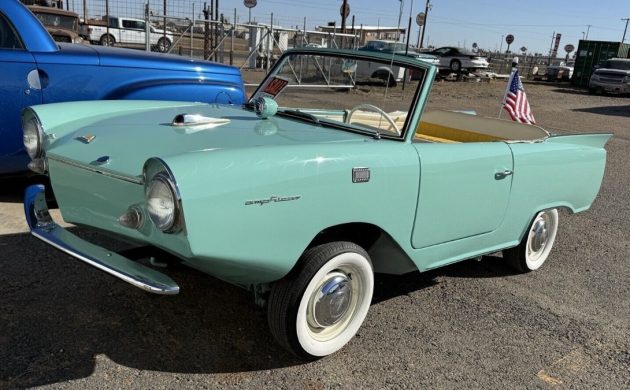
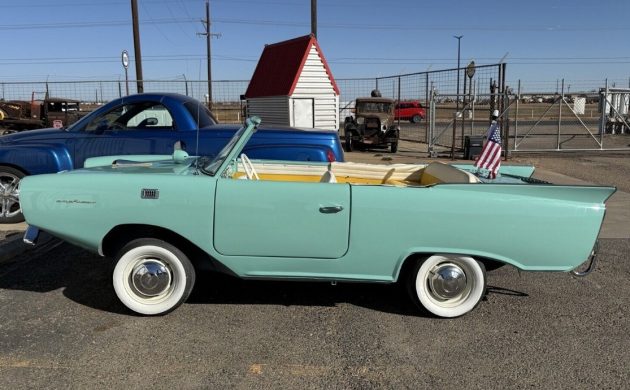
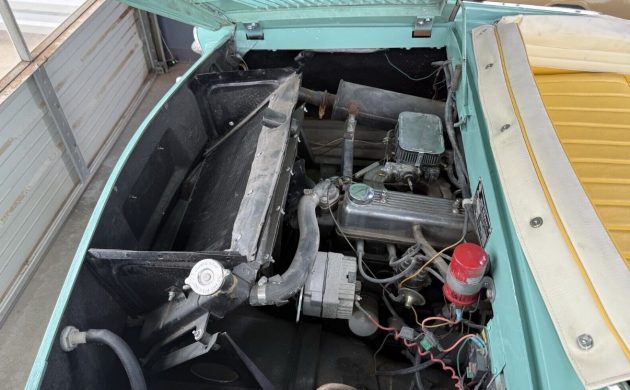
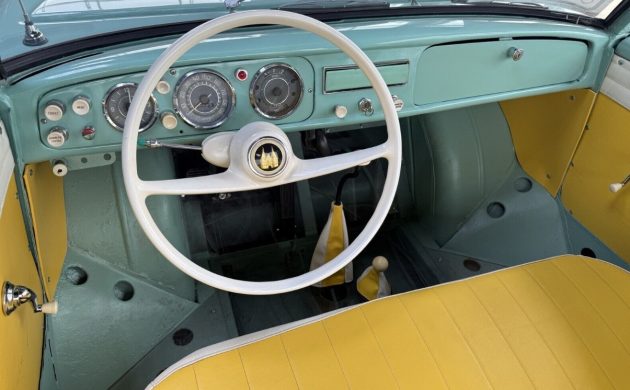
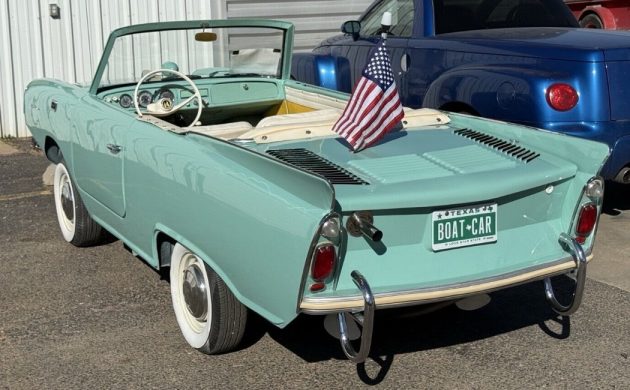





It would be hard to sell an amphibious car in some locales, such as Death Valley or Kansas. This is a nice example shown here, but for over $50k? If someone paid that much they’d truly be underwater.
No longer available. Wow!!
I remember back in the 60’s when Car and Driver did a review of this car and the bottom line was : “Not a very good car, and not a very good boat either”
Sorry to dis your auction owner, it’s just the first thing that came to my mind.
glwta
Flying cars and floating cars are the solution to problems that never existed.
Was a guy in my hometown (Storm Lake, Ia) had one of these. Would take it out on the lake on calm days ONLY. Always drew alot of attention when drove down the boat ramp. As I recall, the car is still there, at the bottom of the lake. Passing speed boat wake and inoperative bilge pump were it’s demise. At that price it BETTER float.
The MSRP for these was 2889. For that money back then, you could get a decent car and a decent little boat and trailer. It’s one of those things where you wonder so much not why they sold so few, but how they sold so many.
I put these on par with the BMW Isetta with its novel one front door.
The automotive landscape in the late 50s early 60s was a marvel of interesting ideas. Few made it to production but at least these two did.
Maybe they meant 7 knots per hour on the water and 70 kilometers per hour on the road, both most likely achieved with a tailwind.
Knots is a velocity
Knots per hour is an acceleration
You should have known
Or a Tug/Tow!
I like the color of the SSR next to it.
@PRA4SNW
I just KNEW someone was going to mention the SSR in the background. Of course it had to be you. 😆
LOL – Of course!
Seriously, though, my wife and I were just talking about selling her Flex and getting something fun to drive. My idea of fun is different than hers, so we have to compromise. We saw an SSR the other day and I remember her mentioning that she liked them when they first came out, so just today I started investigating them. Most of the ones for sale are red, black, or yellow. And then an hour later I see that blue one – we love blue vehicles! That one would match the Bronco nicely.
It’s called Fjord Green and has a Apricot interior. I bought one in 2002. 13K got it running in 3 weeks (parts). Mine is Aqua too. Needs paint also. One went for $126K at an auction a while back.